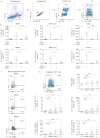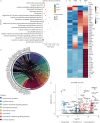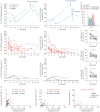Th2-skewed peripheral T-helper cells drive B-cells in allergic bronchopulmonary aspergillosis
- PMID: 38514095
- PMCID: PMC11096668
- DOI: 10.1183/13993003.00386-2024
Th2-skewed peripheral T-helper cells drive B-cells in allergic bronchopulmonary aspergillosis
Abstract
Introduction: Patients with allergic bronchopulmonary aspergillosis (ABPA) suffer from repeated exacerbations. The involvement of T-cell subsets remains unclear.
Methods: We enrolled ABPA patients, asthma patients and healthy controls. T-helper type 1 (Th1), 2 (Th2) and 17 (Th17) cells, regulatory T-cells (Treg) and interleukin (IL)-21+CD4+T-cells in total or sorted subsets of peripheral blood mononuclear cells and ABPA bronchoalveolar lavage fluid (BALF) were analysed using flow cytometry. RNA sequencing of subsets of CD4+T-cells was done in exacerbated ABPA patients and healthy controls. Antibodies of T-/B-cell co-cultures in vitro were measured.
Results: ABPA patients had increased Th2 cells, similar numbers of Treg cells and decreased circulating Th1 and Th17 cells. IL-5+IL-13+IL-21+CD4+T-cells were rarely detected in healthy controls, but significantly elevated in the blood of ABPA patients, especially the exacerbated ones. We found that IL-5+IL-13+IL-21+CD4+T-cells were mainly peripheral T-helper (Tph) cells (PD-1+CXCR5-), which also presented in the BALF of ABPA patients. The proportions of circulating Tph cells were similar among ABPA patients, asthma patients and healthy controls, while IL-5+IL-13+IL-21+ Tph cells significantly increased in ABPA patients. Transcriptome data showed that Tph cells of ABPA patients were Th2-skewed and exhibited signatures of follicular T-helper cells. When co-cultured in vitro, Tph cells of ABPA patients induced the differentiation of autologous B-cells into plasmablasts and significantly enhanced the production of IgE.
Conclusion: We identified a distinctly elevated population of circulating Th2-skewed Tph cells that induced the production of IgE in ABPA patients. It may be a biomarker and therapeutic target for ABPA.
Copyright ©The authors 2024.
Conflict of interest statement
Conflict of interest: The authors have no potential conflicts of interest to disclose.
Figures





Comment in
-
T-cells and precision medicine for allergic bronchopulmonary aspergillosis.Eur Respir J. 2024 May 16;63(5):2400549. doi: 10.1183/13993003.00549-2024. Print 2024 May. Eur Respir J. 2024. PMID: 38754948 No abstract available.
References
MeSH terms
LinkOut - more resources
Full Text Sources
Research Materials
